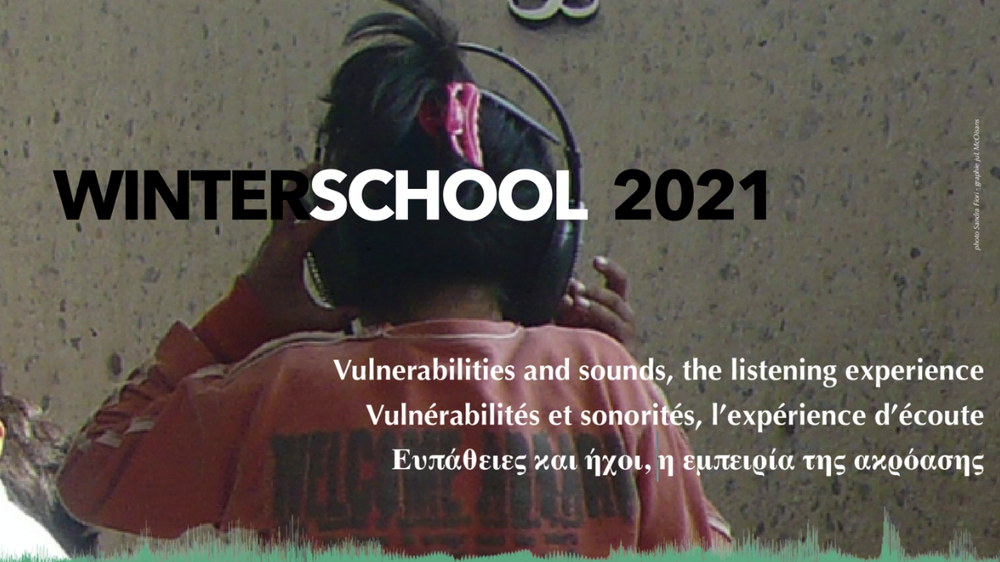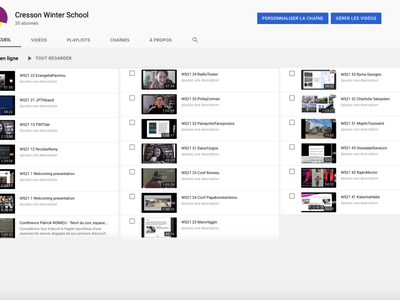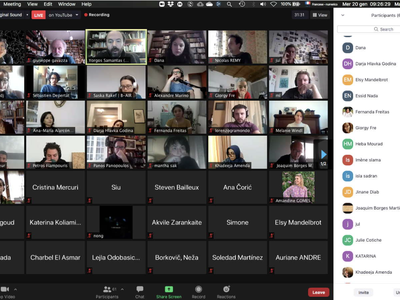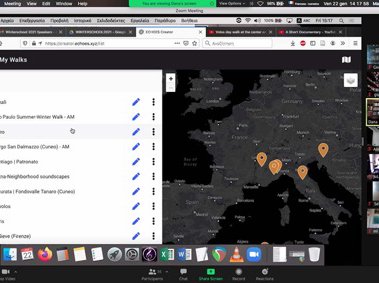In a world where the immediacy of information as well as the quickness of actions have become the rule, it seems more and more challenging to take the time. The acceleration of lifestyles and ways of thinking has become a prerequisite for success. Nevertheless, in parallel with this fast-moving world, long-term issues are being increasingly neglected, creating social, environmental and spatial « vulnerabilities ». It is precisely at the intersection of these stakes that the question of ambiances and more particularly of sounds can appear as a catch. Listening to the environment, a gesture that may seem simple and insignificant, becomes a powerful tool for considering places and words at scales and temporalities that are difficult to reach with the visual.
Sound is a medium intrinsically related to time, but also very capable of questioning scales that are often "left aside" because they appear to be too obvious, too small or on the other hand too large. Sound can therefore be seen as a lever to consider, question or reframe these issues.
It was an opportunity to combine practical training and theoretical discussions with the aim to achieve online production on the Echoes XYZ platform. We questioned sound related to issues of vulnerability, which are of increasing importance nowadays and reinforced by recent crisis; we presented different approaches but also opened up avenues of reflection, exploited during the workshop. The five key structural moments ("the sciences of space", "the world of radio", "artistic practices", and finally "research and prospects with doctorates in progress") joint collaborative creation work around virtual sound walks and were an opportunity to invent and embroider methods of virtual co-creation through multiple digital platforms.
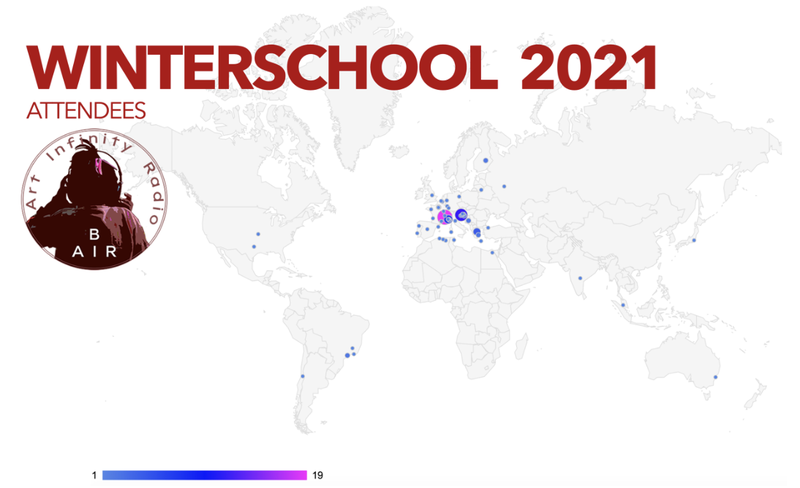
- Welcoming and presentation (Nicolas Rémy & Nicolas Tixier)
- Sound effects of Vulnerability (Nicolas Rémy)
Since the first works of Pierre Schaeffer (The Sound Object 1966), then Murray Schafer on the soundscape (1977), completed by the collective work of Cresson (sound effects 1995), many are now the concepts likely to describe the sound phenomena as they are experienced and produced daily. These works make it possible to describe sonic phenomena on different scales: scale of the sonic sources with the sound object, scale of the body in movement with the sonic effect and scale of the landscape with the soundscape. They articulate perfectly to the attention that we have when we are listening to sound and acting with them. They are also very meaningful and relevant to describe affects produced on the listening and acting subject. They become operators for sound creators (installation, sculpture, radio arts, musical arts) but also for space designers (artists, architects, urban designers). Nowadays, with the revival of the general interest for sound (sound studies), the notion of sonic effect seems the most promising tool to describe our contemporary practices with the sonic environment. Vulnerability of spaces, vulnerability of the environment and vulnerability of social practices will be discussed regarding the sound effect notion. - Echoes of Vulnerability: introduction of the workshop (TWIXTLab)
TWIXTlab’s core contribution for B-AIR is titled “Audibility”, and is concerned with art education and artistic making for Deaf and hard of hearing individuals, especially adolescents, in the fields of sound art and music. In this frame TWIXTlab has the charge to run the workshop of the winterschool and because of the lock down situation, they ran it on line and adressed theoricall and practical issues around the creation of the soundwalks in public spaces. - Sensibilities to LifeWorlds (Jean-Paul Thibaud)
The presentation will explore what could be an atmospheric listening to lifeworlds. It is placed under the sign of the Phonocene (Haraway) and the Phonotop (Sloterdijk). The aim is to understand how sonic experience maintains a fundamental relationship of vulnerability to the world. Atmospheric listening pays attention to the attunements and resonances of any situation, and gives existence to the diffuse, precarious and discreet efficiency of the world of sound. - Infinite Atmospheres for Ethical Design (Evangelia Paxinou)
How does the notion of “infinite places” allow us to question the production of contemporary architectural space? What are the new challenges for the design of the atmospheres of these new forms of public space? This article aims to bring together the urban practices identified by the Encore Heureux collective with a praxeological thought of the creation of atmospheres. Infinites places are analyzed in their potentials to create infinite conflicts, infinite negotiations and infinite sympathies between the back plan and the emerging events. Vulnaribilities of spaces and listening will be discussed in this frame. - In the key of life: the place of sound in the anthropology of Tim Ingold (Marc Higgin)
The anthropological thought of TimIngold is a thought that has been shaped in dialogue; with the Sami communities he lived with during his fieldworkin the 70s and 80s, with the empirical and theoretical richness of the anthropological tradition, with thephenomenology of Merleau-Ponty, Jonas and Heidegger and the pragmatism of Dewey, with evolutionary thoughtin biology and archaeology, with practitionersand theorists in the crafts and arts, in architecture and design. Atthe heart of these dialogues is a concern for understanding how we inhabit the world, how human forms of life arenegotiated with this world in all its material and living diversity, andhow understanding this negotiation requires aprofound re-writing of Western notions of the individual, knowledge and action. This intervention reads Ingold’sbody of work through the question of sound and its role in opening up social life-what it is and what it could be-to thought and action. - Mort du son, espaces de crise. Une ethnographie des traces / Death of sound, spaces of crisis. An ethnography of the tracks/traces (Patrick Romieu (FR))
Patrick Romieu questions his listening and deeply questions his perception of the territory through the repeated and committed listening that he practices daily. The conference is available only in French but ones can come and listen to Patrick Romieu on an intriguing path (the death of sound) or an ethnography of the traces that he has been following since this terrible accident. - Voice, sound and ambiance in cinematic narration (Giorgos Papakonstantinou & Electra Venaki (GR))
A recreational journey through the history of cinema seen through the use of sound and soundscapes - Esthetic of Relation in sonic arts (Dana Papachristou and Georges Samantas)
On the limits of sound art as a socially engaged art practice
In this presentation, we will investigate how sound can function as a weapon/tool towards social inclusion, and problematize the aspects of recorded sound as a technical object. Further, we will draw upon the notion of “synaesthetic translation”, in order to sketch a genealogy of the interchangeability of modalities between art forms or genres, from Benjamin or Schoenberg and Kandinsky to contemporary art and new media applications. Last, we will pose some initial research questions as framed within “Audibility”, (part of “B-Air” Creative Europe project) that invites Deaf or Hard of Hearing students in sound-art and radio-art processes. - Deaf / Sound / Art (Panayotis Panopoulos)
The ways of the deaf with sound reveal the significance of deaf sonic and vocal experiences towards a wider understanding of perception, expression and creativity, both for the deaf and the hearing. The presentation will focus on the relations of the deaf with sound, through vision, voice, touch and vibration, especially as these relations materialize in the work of contemporary artists working on deafness and on alternative sonic perception, or by deaf artists working with sound and voice. I will further refer to my research collaborations (ethnographic/ artistic experimentations with deaf and hearing artists), which focus on a systematic exploration of crossovers between artistic work and anthropological research on sound. - Soundwalks as contemporary art practice: possible ways of listening and sound integration of space and time (Brane Zorman & Irena Pivka for Radio Cona)
Walking as the principle of analogue attunement of mind and movement, as a political act, used today – more than ever – to implicitly express our view on the evaluation of time. Going places on foot is a waste, yet simultaneously a gift of time. Claiming time to move whereby remaining one own’s metronome. In the lecture announced authors will deliberately focus only on their own artistic creations. The presentation will cover their latest performative works, which connect them with walking, listening and using locative media tools, works that are based on the sound field recordings and reflections on the social relations towards society and nature. Through acoustic ecology, the authors want to highlight the perception of our environment, listening and walking as a possible forms of artistic activity, which is extremely important in today’s dramatically changing state of social and cultural landscape. - Radiowalks (Pavlica Bajsic Brazzoduro for Radio Teatar)
Radio Teatar attracts artists from different contexts and generations: radio, theater, music and film artists exploring the points of connection and overlapping of their specific practices with radio practice. Radio art, with its image of the « old media », gives people a sense of connection through different times and spaces, and at RadioTeatar we access it very openly, merging radio with theater, escaping classical performance spaces and formats, focusing primarily on listening as an act of reception but also of personal, mental creation. Beside short presentation of our artistic organisation and our main projects, I will focus on presenting you sort of very personal soundwalks that I have started to develop in Croatia two years ago, entitled: radiowalks. I will present you the following radiowalks: -from a remoted village on island of Hvar (Beetle in the ear, 2018) – from an old food market in the centre of Zagreb (Dolac sleeps, 2020) – from a hotel for immigrants and a torpedo factory from 1920s in Rijeka (Car’s new ear, 2020) – from streets around an old cinema in Zagreb (Cinema for thoughts, 2020) - Music listening – a facilitator of psychological wellbeing (Katarina Habe)
The aim of my presentation is to shed light on the effects of music listening on psychological wellbeing. The presentation is going to be grounded on psychological concepts such as functions of music listening, music preferences, psychological well-being, coping with stress, and experiencing flow. The leading questions I’ll try to answer during the presentation will be as follows: (1) How do different elements of music, such as tempo/rhythm, tonality, musical genre, lyrics, etc. affect listeners’ wellbeing, (2) when, where, and how to listen to the music to promote wellbeing, (3) how to promote the therapeutic value of music in listening to music for the vulnerable groups of people? With regard to the latter, I’m going to present a project, developed and launched by Radio ARS (Slovenia) in collaboration with different experts during the first COVID-19 pandemic lock-down in Slovenia. The mentioned radio literature-music show was developed to enhance wellbeing in elderly people in retirement homes. - Grassroots Music Venues as New Commons: Socialness and Spatialization (Rajko Muršič)
In classical ethnographic report on life at the Trobriands, Bronislaw Malinowski described the institution of bukumatula, the house for the youth, where they would socialize and have first independent life experiences, among them sexual. Having in mind the school, the youth in the west would not have such privileged spaces for socialization. Nevertheless, the youth and younger generations would find their way in occupying public urban space: flaneurs in “decadent” Paris; jazz-dancing audiences in swinging 1930s in USA and Europe; unstoppable rocking’ youth after the 1950s, and partying ravers till the present. The author will present importance of the venues for youth and younger audiences, based on his long-term study of specific grassroots music venues, i.e., alternative music venues, squats and underground venues in Slovenia after WW2. In the last two decades, with the rise of neoliberal capitalism, these venues are in decline. Their essential social importance is in sharp contrast to rising privatization of space. The main point of the presentation will be that they are not obsolete, because they cannot compete with private interests, but, on the contrary, they are fought against as one of eventual counter-powers: they are actually the new commons in space. They are specific commons, spaces of experiencing something we might define as communist, producing spatial, social, auditory and acoustic commons. These venues literally create new common spaces in which sounds of music define new forms of socialness. - Compose to play: scoring organised sounds (Giuseppe Gavazza)
https://www.youtube.com/watch?v=NI--_rYDLJY
I have been teaching composition for many years but the vast majority of my students do not study to become composers but rather music and instrument teachers or even sound technicians. Often the teaching of composition is seen as a rigorous technique that is expressed in a list of prohibitions: a necessary choice to train professionals in composing. I prefer to interpret composition (and words) as an inventive and creative opportunity: between the etymology of the Latin cum ponere=to put together, Edgar Varese’s concept of organized sound, playing as a game and the music score as the score of this game. My students are mature musicians: each has their own cultural, musical and life background. The challenge for me, as a teacher, is to make them understand that they are already composers by putting together, in an inventive gesture, what they already know. I hope that they, as teachers, will then do the same with their pupils. The aim is not to train professional composers but to make them understand that not only performing but also creating with sounds is a great making music; and it can be good for people, whether they are musicians or not. - IDEN, Electroacoustic Radio Opera (Tina Kozin, Saška Rakef and Bojana Šaljić Podešva)
"What lies behind human endeavours to preserve biotic diversity, habitats, endangered species? Do they originate in care towards nature or rather care for oneself? Or perhaps, more than care, one’s fear – of transience, of change, fear of death?"
The electroacoustic radio opera Iden conveys a story of the Curonian Spit sand dune in Lithuania, a temporary geographical phenomenon under the protection of Unesco as world cultural and natural heritage. It is a story of a conflict of interests inscribed in the management of national parks, as well as a story of prehistorical struggle of man with inevitable change, passing, transience.
https://f-origin.hypotheses.org/wp-content/blogs.dir/1111/files/2021/01/IDEN.pdf https://soundcloud.com/bojana-alji-p/iden/s-J9Fi1
Co-production: 3. program Radia Slovenija – program Ars, društvo Celinka, ŠKUC gledališče. In collaboration with: Cona, Umetniška kolonija Nida – Akademija umetnosti v Vilni. - Round Table 1 : Vulnerability and space (Maïlys Toussaint) "Sharing the daily experience in a city neighborhood, the Villeneuve Grenoble"
By studying the inhabitant’s daily experiences during the rehabilitation of their building through qualitative methods of inquiry, this research aim to understand the habits and the habituations process of inhabitants in this context of transformations and changes. In the same time that we try to share the daily life and the problematics of those who inhabit the urban renewal, this research try to understand the purpose and the impact of habits and habituations within the urban renewal, and to bring elements for understanding links between the small scale of inhabitants practices and perceptions and the big scale of urban renewal. During this round table "vulnerability and space", we will talk about the noise disturbances of the constructions site, by sharing interviews and field narratives extracts. By those field data, we will try to see how the construction noises question the inhabitant’s way of living, and how this can bring us to question the notion of vulnerability. - Round Table 2 : Vulnerability vs environment (Charlotte Laffont & Sebastien dePertat)
"Anthropocene atmospheres. Listening to our living environments"
Based on reflections on the evolution of our listening to the environment since the COVID-19 pandemic, Charlotte Laffont will outline a definition of vulnerability in the environment. She will consider the place of nature, but especially of agriculture in cities, as a hypothesis of response to this vulnerability for our cities of tomorrow. Based on listening to urban vegetable gardens conducted at the beginning of her research, she will present the methods envisaged in her work and the environmental and sound questions raised by the practice of agriculture in the city. - Round Table 3 : Social Vulnerability Beirut, heterogeneity and struggle of ambiances in enclosed neighborhoods (Georges Abou Mrad)
Based on the complex community and societal context of Lebanon and above all of its capital Beirut, this thesis questions identity conflicts and what arises from a struggle of ambiences in two irregular neighborhoods of Greater Beirut. The districts of "Ouzaï" and "Karm El Zeitoun – Syriac" are made up of heterogeneous ambiences and identities, conceived due to different uses and activities. Today surrounded by a speculative urban transformation, how can we imagine their future? The thesis will be based on situated work and surveys to update the constitutive elements of this "heteroclicity". What possible role is for ambiences in future evolutions of these neighborhoods? - To make heritage / to make a project for la Capuche, l’Abbaye and Jean Macé; Three low-rent housing from Grenoble with a contrasted future (Ryma Hadbi)
This research project questions what makes heritage in three neighborhoods of low-rent housing in Grenoble built during the period from 1920 to 1930: l’Abbaye, la Capuche and Jean Macé. These neighborhoods originally shared a number of similarities in terms of their construction, however they went through a number of transformations. We consider the hypothesis that what makes heritage consists of three patrimonial values: historical value, usage value and the value of renewal. What makes heritage stems from a common interest for the vitality of these neighborhoods and the population who « invented » them by their real-life experiences and their stories. From the inhabitants narratives, we will question the social vulnerabilities of these neighborhoods through a focus on sound.
General Chair: Théo Marchal & Sébastien De Pertat (Grenoble) Nicolas Rémy & Evangelia Paxinou (Volos)
with Françoise Acquier, David Argoud, Pavlica Bajsic Brazzoduro, Giuseppe Gavazza, Katarina Habe, Marc Higgin, Tina Kozin, Charlotte Laffont, Théo Marchal, juL McOisans, Rajko Muršič, Panayotis Panopoulos, Dana Papachristou, Giorgos Papakonstantinou, Evangelia Paxinou, Sébastien de Pertat, Irena Pivka, Radio Cona, Radio Slovenija, RadioTeater, Saška Rakef, Nicolas Rémy, Patrick Romieu, Bojana Šaljić Podešva, Georges Samantas, Jean Paul Thibaud, Nicolas Tixier, Maïlys Toussaint, TwixTlab, Brane Zorman
